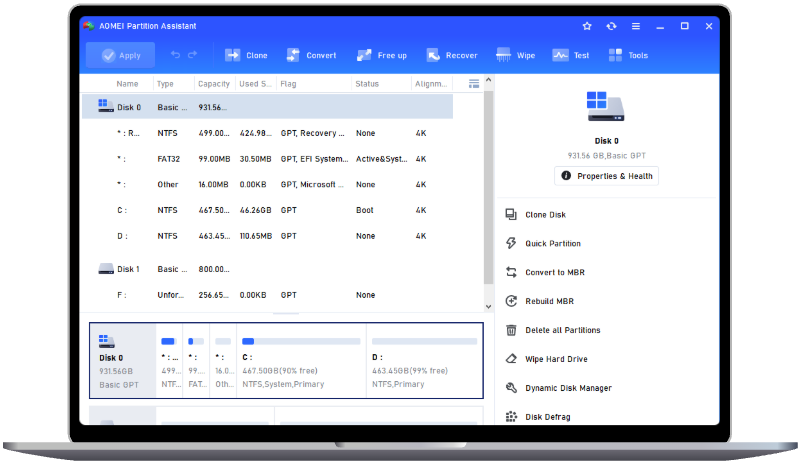How to Replicate a Hard Drive to HDD/SSD on Windows PCs?
Replicating a hard drive is essential for creating backup, migrating system, or upgrading to a larger storage device. This guide provides step-by-step instructions on how to replicate a hard drive using a professional tool. Whether you're a novice or an experienced user, this solution ensures a seamless and error-free hard drive replication process.
I’m planning to upgrade my old hard drive to a new SSD for better performance, but I’m not sure how to replicate all my data without loss. Can someone guide me on how to do it step by step? Any help would be appreciated!
- Question from User
Hard drive replication, also known as cloning, is the process of creating an exact copy of all the data from one hard drive and transferring it to another. This includes not only your personal files but also the operating system, applications, hidden partitions, and boot files.
By replicating a hard drive, you can create a backup of your data, migrate your system to a new PC, or upgrade to a larger storage device. If you are seeking an easy and effective way to replicate a hard drive on Windows PCs, keep reading this post to find the answer!
How to Replicate a Hard Drive to HDD/SSD on Windows PCs?
Replicating a hard drive may sound complicated, but with the right tools and steps, it can be a straightforward process. AOMEI Partition Assistant is a highly recommended tool that helps replicate hard drives with just a few clicks. This user-friendly and reliable software allows you to replicate hard drives to SSDs or larger HDDs, making it ideal for disk upgrades or data backups on Windows 11, 10, 8/8.1, and 7.
- Supports cloning only the used sectors of the hard drives.
- Allows you to resize partitions on the target disk before starting the cloning process.
- Automatically performs 4K alignment for SSDs, optimizing their performance and extending their lifespan.
- Supports the cloning process for drives with bad sectors, ensuring your data is transferred safely.
Follow these steps below to replicate your hard drive right now!
Stage 1. Connect the Target Drive to Your PC
Before you start the replication process, you’ll need to connect the target hard drive where you want to save data to your PC first.
Step 1: Choose a target drive with enough storage capacity to save all the data from your source drive.
Step 2: Install the second drive on your PC or connect it using a USB connector.
Step 3: If the target drive is new, you may need to initialize it. Otherwise, it will not be recognized by Windows. You can use the "Initialize Disk" feature within AOMEI Partition Assistant.
It is advised to set the partition style to be the same as the old hard drive. If the target drive has a different disk type, you can convert from MBR to GPT or GPT to MBR.
Stage 2. Replicate Hard Drive to HDD/SSD
After successfully connecting your drives, let’s move on to how to replicate a hard drive using AOMEI Partition Assistant:
Step 1: Install and launch AOMEI Partition Assistant. Then, click the "Clone" tab and select "Clone Disk".
Step 2: Choose the source disk that you need to clone and click "Next".
Step 3: Choose the target disk where you want to save the data and click "Next".
Step 4: In the Confirm interface, you can check the source and target disk. After all is set, you can click "Confirm" to continue.
Note:
• If you want to clone a hard drive to SSD, tick "4K Alignment" to optimize the SSD’s performance.
• If you select the "Sector-by-Sector Clone" mode, it will be unable to resize the target partition.
Step 5: If you want to adjust the partition size on the target disk, click "Settings" and select the option that best suits your needs.
Step 6: To commit the "Pending Operations", please click "Apply" and "Proceed".
Step 7: The cloning process will start and you can check the cloning process. Once it is completed successfully, you will get a congratulation window.
Stage 3. Change the Boot Drive
If you’re replicating your system drive, you’ll need to change the boot drive to the target drive to ensure your PC boots from the cloned drive. Follow these steps to do that:
Step 1: Restart your computer and press the appropriate key (usually F2, F12, Del, or Esc) to enter the BIOS/UEFI settings.
Step 2: Navigate to the Boot menu and change the boot order to prioritize the target drive.
Step 3: Save the changes and exit the BIOS/UEFI. Then, your PC should now boot from the cloned drive.
Conclusion
Replicating a hard drive on Windows PCs is a practical solution for backing up data, migrating systems, or upgrading storage. By following the steps outlined in this guide, you can easily replicate a hard drive to SSD/HDDusing this professional tool. Whether you’re a beginner or an advanced user, this process is straightforward and ensures your data remains safe and accessible. Additionally, AOMEI Partition Assistant includes various features to manage your disk partitions, such as resizing/moving partitions, migrating OS to SSD, and allocating free space.
FAQs
Q1: Can I replicate a hard drive by manually copying and pasting?
No, manually copying and pasting files from one drive to another is not the same as replicating a hard drive. While copying and pasting can transfer your personal files, it won’t replicate the operating system, hidden partitions, boot files, or applications.
Q2: What should I do if the cloning process fails?
If the cloning process fails, ensure that both the source and target drives are properly connected and functioning. You can also try using a different cloning tool or checking for errors on the source drive.
Q3: Is it safe to replicate a hard drive?
Yes, replicating a hard drive is safe as long as you follow the correct steps and use reliable software. Always back up essential data to avoid unexpected errors.


